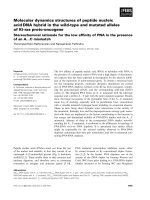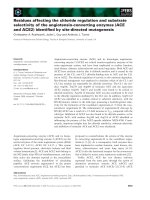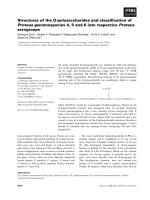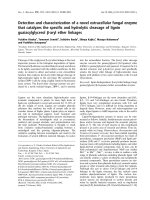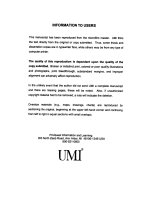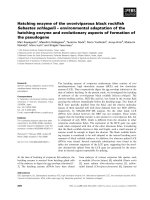14 IMPROVING THE AUDIT PROCESS AND AUDIT METHOD OF ACCOUNT PAYABLE TO SUPPLIERS
Bạn đang xem bản rút gọn của tài liệu. Xem và tải ngay bản đầy đủ của tài liệu tại đây (1.14 MB, 80 trang )
MINISTRY OF FINANCE
ACADEMY OF FINANCE
--------------------
NGUYEN QUOC HUNG
GRADUATION THESIS
MENTOR: Assoc. Prof. PhD. Nguyen Trong Co
Assoc. Prof. Ph.D. Chuc Anh Tu
IMPROVING THE AUDIT PROCESS AND AUDIT METHOD OF
ACCOUNT PAYABLE TO SUPPLIERS
IN FINANCIAL STATEMENTS AUDIT PERFORMED BY HA
THANH AUDIT COMPANY LIMITED
Major: Auditing
Code: 18CL73403010155
HA NOI – 2022
MINISTRY OF FINANCE
ACADEMY OF FINANCE
--------------------
NGUYEN QUOC HUNG
GRADUATION THESIS
MENTOR: Assoc. Prof. PhD. Nguyen Trong Co
Assoc. Prof. Ph.D. Chuc Anh Tu
IMPROVING THE AUDIT PROCESS AND AUDIT METHOD OF
ACCOUNT PAYABLE TO SUPPLIERS
IN FINANCIAL STATEMENTS AUDIT PERFORMED BY HA
THANH AUDIT COMPANY LIMITED
Major: Auditing
Code: 18CL73403010155
HA NOI – 2022
GUARANTEE
I hereby declare that this is my own research work. The data and results stated in
the final thesis of this course are collected and quoted by me, absolutely not copied
from any documents.
Author
NGUYEN QUOC HUNG
TABLE OF CONTENT
COVER……………………………………………………………………………
ABBREVIATION
LIST OF TABLE…………………………………………………………………v
LIST OF ABBREVIATION
BOD
Board of Directors
Co., Ltd.
Company Limited
LIST OF TABLES
INTRODUCTION
1.The urgent of the topic
In the 4.0 industrial revolution, information of companies is not only served
for the management of State agencies and internal users but also taken advantage
of by other external users especially investors of joint-stock companies. Therefore,
obviously publicing financial statements and information are becoming more and
more compulsory. This increases a chance for audit services in general and external
audit in particular to improve skyrocketing. With a view to giving independent
audit opinion of auditors about the faithfulness and appropriateness of material
aspects of information represented in financial statements, external audit is taking
an important part in completing and improving the audit process and audit method.
Among accouting sections in financial statement, account payable to suppliers
is one of the most important section as it impacts directly on the liquidity and
going concern of the company. In reality, some companies record and manage that
section wrongly or tend to hide the information to misrepresent the financial
statement so auditing that section is significantly material in auditing financial
statement.
Ha Thanh Audit Company Limited is not an elderly founded company so
improving the audit process and audit method of audit especially account payable
to suppliers is the considerably material which BOD should puts it to the top. Due
to the fact that company is not founded long ago and is not a big firm so audit
process and audit method of Ha Thanh Audit Company Limited stil has a few
weaknesses. That may afffect company’ reputation and distract the attraction to
potential clients.
With some reasons above and with the help of lecturers Assoc. Prof. PhD
Nguyen Trong Co, Assoc. Prof. PhD Chuc Anh Tu and detailed from Ha Thanh
Audit Company Limited , I choose the topic of my graduation thesis: “Improving
the audit process and audit method of account payable to suppliers in Financial
Statements Audit performed by Ha Thanh Audit Company Limited”.
2. Research of objective
First, systematize the main arguments and clarify the audit process and audit
method of account payable to suppliers in the audit of financial statements
performed by independent auditors.
Second, survey on the current state of the audit of account payable to suppliers
in audit of financial statements performed by Ha Thanh Audit Company Limited.
Finally, assessing the current state of the audit process and audit method of
account payable to suppliers in audit of financial statements performed by Ha
Thanh Audit Company Limited, and suggesting some improvements.
3. Research subjects and scope of research
3.1. Research subjects
Sample process and method and implementation practice of the account
payable to suppliers in the audit of financial statement performed by Ha Thanh
Audit Company Limited.
3.2. Research scope
The scope of the study is the process and method of auditing account payable
to suppliers in audit of financial statements performed by Ha Thanh Audit
Company Limited. Collected data are documents, audit records of account payable
to suppliers in 2021 and ago.
4. Research Methodology
4.1. Collect data
Data is collected from information sources outside the company such as
research projects, theses, reports, articles, etc. related to the process and method
of auditing account payable to suppliers in audit of financial statements
performed by Ha Thanh Audit Company Limited.
Legal documents, charters and standards related to the audit of account
payable to suppliers in financial statements audit of Vietnam.
Data collected from reports, documents and papers circulating in the company
related to the audit of account payable to suppliers in Financial Statements Audit
has been previously performed by Ha Thanh Audit Company Limited.
Data related to the topic from previous audits, comments, assessments,
conclusions and audit reports on account payable to suppliers. Other tables,
procedures and regulations.
4.2. Data prcocessing
Analyze and process information based on obtained knowledge from the collected
documents and data in order to create my own conclusions about the process and
method of auditing account payable to suppliers in audit of financial statements
performed by Ha Thanh Audit Company Limited. After that, offer suggestions and
recommendations for improving the Company's account payable to suppliers
auditing procedure.
5. The structure of the thesis
The structure of the thesis:
Introduction
Chapter 1: Basic theories on the process and method of auditing account payable to
suppliers in Financial Statements Audit performed by an independent auditing
company.
Chapter 2: Acctual status of the process and method of auditing account payable to
suppliers system in Financial Statement Audit performed by Ha Thanh Audit
Company Limited.
Chapter 3: Improvements to process and method of auditing account payable to
suppliers in Financial Statements Audit performed by Ha Thanh Audit Company
Limited.
CHAPTER 1:
BASIC THEORIES ON THE PROCESS AND METHOD
OF AUDITING ACCOUNT PAYABLE TO SUPPLIERS IN FINANCIAL
STATEMENTS AUDIT PERFORMED BY AN INDEPENDENT AUDITING
COMPANY.
1.1. Overviews of account payable to suppliers in financial statement.
1.1.1. The legal definition and role of account payable to suppliers.
Account payable to suppliers or so called “Trade payables” is a part of Liabilities
which is according to Circular_200_2014_TT-BTC:
Article 50. Accounting rules for liabilities
1. Liabilities of an enterprise must be kept records in details according to payment
schedule, creditor, type of currency and other factors according to requirements of
the enterprise.
2. Liabilities shall be classified into trade payables, intra-company payables and
other payables according to following rules:
a) Trade payables include commercial amounts payable arisen from purchase of
goods, services or asset and the seller is independent with the buyer, including
amounts payables between parent company and subsidiaries, joint ventures or
associates). Amounts payable include amounts payable when importing through
the trustee (in the import trust transaction);
b) Intra-company payables include amounts payable between parent company and
dependent accounting subsidiaries having no legal status;
c) Other payables include non-commercial amounts payable, or amounts payable
relating to trading in goods or services:
- Payables relating to financial expenses, such as: interests payable, dividends
payable and profits payable, financial investment expenses payable;
- Payables paid by another party; payables which the trustor receives from relevant
entities to pay for import-export trust transactions;
- Non-commercial payables, such as: borrowings payable, fines payable,
compensation payable, assets in surplus awaiting resolution, payables related to
social insurance, health insurance, unemployment insurance, or union funds, etc.
3. When preparing a financial statement, the amounts payable shall be classified
into long-term payables or short-term payables according to their remaining terms.
4. If it is evident that there is an unavoidable loss, an amount payable shall be
recorded according to cautious rules.
5. When preparing the financial statement, these amounts payable meeting
definition of accounts derived from foreign currencies (refer to account 413 –
Exchange rate differences) for re-valuation at the ending of accounting period.
So account payable to suppliers (Trade payables) is the account which
“include commercial amounts payable arisen from purchase of goods, services or
asset and the seller is independent with the buyer, including amounts payables
between parent company and subsidiaries, joint ventures or associates). Amounts
payable include amounts payable when importing through the trustee (in the import
trust transaction)”.
Account payable to suppliers is the present obligation of the company occurred
from transactions and events in the past which company has to pay for using its
sources. Account payble to suppliers determines the present obligation of the
company when it received an asset, participated in a commitment or occurred a
legal obligation.
1.1.2. The features of account payable to suppliers that affect the
audit process and audit method.
Account payable to suppliers (Trade payables) is a part of the calculation of the
company’s credit rating by external evaluators such as banks when evaluating the
credit ratings of different companies. Large balances of trade payables mean lower
credit ratings placed by the evaluators on the company.
Accounts payable specialists provide organizations with authoritative, up-todate financial information that displays the company's current financial health,
which can influence the decisions that financial planners make about the
company's expenses. Understanding the company's upcoming obligations and
debts in repayment can help strategists ask informed questions in an effort to
positively affect the company's net income statement.
1.1.3. Accounting principle on recognition of account payable to
suppliers
In the process of producing and businessing of any enterprises, to mainting the
going concern and productivity they have to ensure inputs such as goods,
equipments, assets and services, outside purchasing services. With the
development trend of economy, beside the relationship “ Purchase” and “Pay
immediately” , the “Purchase on credit” is now becoming more and more popular.
According to Circular_200_2014_TT-BTC, account payable to suppliers (Trade
payables) is said in Articale 51 that:
Article 51. Account 331 - Trade payables
1. Rules for accounting.
a) This account is used to record payment of liabilities of an enterprise to the
sellers of materials, goods or suppliers of services, sellers of fixed assets,
investment properties or financial investment under concluded business contracts.
This account is used to record the payment of liabilities to main contractors or sub
contractors. The buy in cash shall not be recorded to this account.
b) Liabilities to sellers, providers or contractors shall be kept records in details for
every entity. This account also records prepayment to the sellers, providers or
contractors but the goods, services or constructions have not been received.
c) The enterprise must keep records of trade payables in details for each type of
currency. With regard to trade payables in foreign currencies, the rules below shall
be followed:
- When incurring trade payables (Cr 331) in foreign currencies, those payables
shall be converted into VND according to actual exchange rates at the incurring
time (selling exchange rate of the commercial bank where the enterprise regularly
enters into transactions). With regard to prepayment to contractors or sellers, when
it is qualified to record assets or expenses, the Cr 331 shall apply specific
identification bookkeeping rate for the amounts of prepayment.
- When paying trade payables (Cr 331) in foreign currencies, those payables shall
be converted into VND according to specific identification bookkeeping rates for
every creditor (if the creditor has multiple transactions the specific identification
bookkeeping rate shall be determined according to mobile weight average of such
transactions). When entering into a transaction in prepayment to contractors or
sellers, the Dr 331 shall be applied actual exchange rates (selling rates of the
commercial bank where the enterprise regularly enters into transactions) at the time
in which the prepayment given;
- The enterprise must re-evaluate trade payables derived from foreign currencies on
the dates on which the financial statements are prepared as prescribed. Actual
exchange rates determined when the trade payables are re-evaluated is selling rates
of the commercial bank where the enterprise regularly enters into transactions on
the date on which the financial statement is prepared. Units in a group shall apply a
common rate defined by the parent company (provided that it closes to the actual
exchange rates) to re-evaluate trade receivables derived from foreign currencies
arising from transactions of internal group.
d) The import trustor shall record the trade payables for imported goods to the
import trustee to this account similarly to ordinary trade payables.
dd) At the end of a month, if there has not been invoices of received materials,
goods or services, provisional prices may be used for bookkeeping, when those
invoices are received, the prices must be adjusted and the seller shall be notified
the official prices.
e) When those accounts are accounted in details, if the payment discounts, trade
discounts or sales rebates of the seller or the supplier are not recorded in the sales
invoices, they must be kept records in details.
2. Structure and contents of account 331 – Trade payables
Debit:
- Amounts paid to sellers, suppliers or contractors;
- Prepayment to sellers, suppliers, contractors but materials, goods, services and
constructions are not received;
- Amounts of sales approved by sellers;
- Payment discounts and trade discounts which the sellers approve for enterprises
to deduct from trade payables;
- Value of materials or goods in shortage or inferior quality which are received
back by the sellers.
- Re-evaluation of trade payables in foreign currencies (if the foreign currency rate
falls against VND).
Credit:
- Amounts payable to sellers, suppliers or contractors;
- Adjustment of negative difference between provisional price and actual price of
amount of materials, goods and services when the invoice or notification of official
price is received.
- Re-evaluation of trade payables in foreign currencies (if the foreign currency rate
rises against VND).
Credit balance: Outstanding balance payable to sellers, suppliers or contractors.
This account may have a Debit balance. Debit balance (if any) records prepayment
to sellers or payment in excess of payables to sellers, according to every specific
subject. When preparing the balance sheet, detailed balance of every subject
reflected in this account will be taken to record to “Assets” and “Capital” account.
3. Method of accounting for several major transactions
3.1. When purchasing materials or goods without payment for inventory using
perpetual inventory method or purchasing fixed assets:
a) Domestic purchase:
- If the input VAT is deductible, the following accounts shall be recorded:
Dr 152, 153, 156, 157, 211, 213 (VAT-exclusive prices)
Dr 133 – Deductible VAT (1331)
Cr 331 – Trade payables (total payment).
- If the input VAT is not deductible, the value of materials, goods or fixed assets
shall include VAT (total payment).
b) Import:
- Value of imported goods, including special excise tax, export duty or
environmental protection tax (if any) shall be recorded as follows:
Dr 152, 153, 156, 157, 211, 213
Cr 331 – Trade payables
Cr 3332 – Special excise tax (if any)
Cr 3333 – Import – export duty (in details, if any)
Cr 33381 - Environmental protection tax
- If the input VAT is deductible, the following accounts shall be recorded:
Dr 133 – Deductible VAT (1331)
Cr 3331 – VAT payables (33312).
3.2. When purchasing materials or goods without payment for inventory using
periodical inventory method:
a) Domestic purchase:
- If the input VAT is deductible, the following accounts shall be recorded:
Dr 611 – Purchase (VAT-exclusive prices)
Dr 133 – Deductible VAT
Cr 331 – Trade payables (total payment).
- If the input VAT is not deductible, the value of materials or goods shall include
VAT (total payment)
b. Import:
- Value of imported goods, including special excise tax, export duty or
environmental protection tax (if any) shall be recorded as follows:
Dr 611 - Purchase
Cr 331 – Trade payables
Cr 3332 – Special excise tax (if any)
Cr 3333 – Import – export duty (in details, if any)
Cr 33381 - Environmental protection tax
- If the input VAT is deductible, the following accounts shall be recorded:
Dr 133 – Deductible VAT (1331)
Cr 3331 – VAT payables (33312).
3.3. If the enterprise carries out capital investment under contract awarding and
receives completed construction from the contractor, according to awarding contract
and transfer note of completed construction:
- If the input VAT is deductible, the following accounts shall be recorded:
Dr 241 – Construction in progress (VAT-exclusive prices)
Dr 133 – Deductible VAT
Cr 331 – Trade payables (total payment).
- If the input VAT is not deductible, the value of capital investment shall include
VAT (total payment)
3.4. When paying advance or paying trade payables to sellers, providers or
contractors, the following accounts shall be recorded:
Dr 331 – Trade payables
Cr 111, 112, 341, etc.
- When paying to the contractor in foreign currencies, those payables shall be
converted into VND according to actual exchange rates at the incurring time
(selling exchange rate of the commercial bank where the enterprise regularly enters
into transactions).
- When paying an advance to the contractor in foreign currency, the value of capital
investment shall be recorded corresponding to the amount of advance according to
actual exchange rates at the time in which the advance is given. The outstanding
balance payable of capital investment (after deducted from the advance) shall be
recorded to actual exchange rates at the incurring time.
Dr 331 – Trade payables (actual exchange rates)
Dr 635 – Financial expenses (if the actual exchange rate is smaller than
bookkeeping rate of the cash account)
Cr 111, 112, etc. (bookkeeping rate)
Cr 515 – Financial income (if the actual exchange rate is greater than bookkeeping
rate of the cash account)
3.5. When receiving back the advance from the seller because the seller fails to sell
goods or provide services, the following accounts shall be recorded:
Dr 111, 112, etc.
Cr 331 – Trade payables.
3.6. When receiving services rendered (expenses incurred from goods
transportation, electricity, water, telephone, auditing, consultancy, advertisement
and other services) from suppliers:
- If the input VAT is deductible, the following accounts shall be recorded:
Dr 156 – Goods (1562)
Dr 241 – Construction in progress
Dr 242 – Prepaid expenses
Dr 623, 627, 641, 642, 635, 811
Dr 133 – Deductible VAT (1331) (if any)
Cr 331 – Trade payables (total payment).
- If the input VAT is not deductible, the value of services shall include VAT (total
payment)
3.7. When receiving payment discounts on sale of materials or goods due to
prepayment and deducting trade payables, the following accounts shall be
recorded:
Dr 331 – Trade payables
Cr 515 – Financial income.
3.8. When purchased materials and goods are returned or eligible for sales rebates
because they do not meet specification and quality, they shall be deducted from
trade payables and the following accounts shall be recorded:
Dr 331 – Trade payables
Cr 133 – Deductible VAT (1331) (if any)
Cr 152, 153, 156, 611, etc.
3.9. In case liabilities paid to sellers (creditors) who were not found out or they did
not call loans, the debts shall be recorded as an increase in enterprises’ income as
follows:
Dr 331 – Trade payables
Cr 711 – Other income.
3.10. When determining value of construction volume payables to subcontractors,
according to the contract signed between main contractor and sub contractor,
invoices, voucher of project price, acceptance report of completed construction
volume and sub bidding contract, the following accounts shall be recorded:
Dr 632 – Costs of goods sold (VAT-exclusive prices)
Dr 133 – Deductible VAT (1331)
Cr 331 – Trade payables (total payables to the subcontractor, including input VAT).
3.11. Enterprises which are commission agents for sale at fixed prices.
- When receiving goods for wholesale, the enterprise shall report them in the
financial statement.
- When receiving wholesale goods, the following accounts shall be recorded:
Dr 111, 112, 131, etc. (total payment)
Cr 331 – Trade payables (agency prices + taxes).
And the enterprise shall report sold goods for wholesale in the financial statement.
- When determining commission earned by the agent who is charged to
commission revenue for wholesale, the following accounts shall be recorded:
Dr 331 – Trade payables
Cr 511 – Revenues
Cr 3331 – VAT payables (if any).
- When paying to consignor, the following accounts shall be recorded:
Dr 331 – Trade payables (selling prices - taxes).
Cr 111, 112, etc.
3.12. Accounting for trade payables at the import trustor:
- When prepaying an amount for import entrustment contract to the import trustee
to open L/C, etc, the following accounts shall be recorded according to relevant
documents:
Dr 331 – Trade payables (every trustee in details)
Cr 111, 112, etc.
- When receiving import entrustment goods delivered by the trustee, it shall follow
procedures for ordinary imported goods.
- When paying for imported goods and directly-attributable expenses incurred from
imported goods to the trustee, the following accounts shall be recorded according
to relevant documents:
Dr 331 – Trade payables (every trustee in details)
Cr 111, 112, etc.
- Import entrustment fees paid to the trustee shall be recorded to value of imported
goods; the following accounts shall be recorded according to relevant documents:
Dr 151, 152, 156, 211, etc.
Dr 133 – Deductible VAT
Cr 331- – Trade payables (every trustee in details)
- The payment of tax liability for imported goods shall comply with regulations of
account 333 – Taxes and other payables to the State.
- The trustee may not use this account to record payment of entrustment but record
to account 138 and 338.
3.13. When preparing a financial statement, the outstanding trade payables in
foreign currency shall be evaluated according to actual exchange rates on the date
on which the financial statement is prepared:
- If the foreign currency rate falls against VND, the following accounts shall be
recorded:
Dr 331 – Trade payables
Cr 413 – Exchange rate differences (4131).
- If the foreign currency rate rises against VND, the following accounts shall be
recorded:
Dr 413 – Exchange rate differences (4131).
Cr 331 – Trade payables.
1.1.4. The company’ account payable to suppliers internal control
system.
The arising account payable to suppliers (Trade payables) transactions is
considered to be impactful and has a relatively significant effect on the operation
and business performance of enterprises, so it requires a process which has tight
control. The basic work steps that must be performed to handle transactions on
Trade payables include:
-Deal with the purchase order and sign in the purchasing contract.
-Review, approve and handle goods, facilities and services receive.
-Process and recognize the amount of account payable to suppliers (Trade
payables).
-Process, pay invoice and organize the record of the transactions.
In order to build an internal control system for account payable to suppliers
(Trade payables) , an entity usually has to do the following:
- Issue management regulations in general and in particular for account payable to
suppliers (Trade payables). These regulations include regulations on assigning
separate functions and responsibilities to officers, employees and departments in
the unit. At the same time, set specific regulations and clear instructions on the
work steps, the order of recording to strictly control account payable to suppliers
(Trade payables).
-Organize to conduct rights and obligation about manage and control above:
requiring employees to perform jobs according to regulations; disseminate internal
control regulations and regulations in general and internal control for account
payable to suppliers (Trade payables) in particular; check the implementation of
the above internal audit procedures to ensure the effectiveness of the system.
-In organizing to observe rights and obligation about account payable to suppliers
(Trade payables) enterprises have to conform to some principles:
+Implementing segregation of duties: Allocate separately purchasing job,
accountant for Trade payables,… to maintain the fluency of business and increase
people to be responsible for control.
+Implementing the authorization : Enterprises must have clear and suitable
regulations about the jurisdiction of any levels of control system.
+Organizing and controlling bookkeeping and recording account ledgers to ensure
the correctness and sufficiency of ledgers.
1.2. The process of an independent audit firm auditing the account
payable to suppliers.
1.2.1. General about account payable to suppliers auditing.
1.2.1.1. The important of account payable to suppliers auditing in
financial statement auditing.
Account payable to suppliers (Trade payables) often takes an important
position in the process of financial statement auditing as it is one of the most
significant important liabilities in entreprises.
In addition, the audit of Account payable to suppliers (Trade payables) also
assesses the economy, efficiency of investment, orientation for investment so as to
achieve the highest efficiency as it impact hugely on the external investors or other
external users using the Financial Statement.
1.2.1.2. The goal and the basis of account payable to suppliers
audit.
a, Objectives.
*Overall objective:
-Determine whether the trustfulness and fairness of account payable to
suppliers (Trade payables) is sufficient, true and appropriate.
-Determine the trustfulness and fairness of the presentation of financial
statement.
*Specific objective
Evaluate the effectiveness or weakness of the internal control system for
account payable to suppliers (Trade payables) through:
Evaluate the design stage of internal control regulations related to account
payable to suppliers (Trade payables) on the following assertions: Occurrence,
Valuation, Completeness, Accuracy, Cut-off, Right and obligation.
Evaluating the operation stage in terms of: Effectiveness and effectiveness
continuously.
Confirm the truthfulness and reasonableness of the data and information
related to the account payable to suppliers (Trade payables), ensure that the data
bases related to the item are correct:
Rights and obligations: These obligations may include further penalties
(obligations) if the client delays the payments. This can be verified by reading
the terms of contract among creditors and client.
(2) Accuracy: Verification of accuracy is to find if the totals extracted from
individual balances are performed precisely. Recalculations procedures are
carried out to audit this assertion.
(1)
(3) Completeness: It is the verification of accounts payables balances and
checking if the general ledger balances are complete according to real
payables listings. Sending direct confirmations to vendors will help in
verifying these balances.
(4)
Occurrence: Transactions related to account payable to suppliers (Trade
payables) which are recorded must occur.
(5)
(6)
Valuation: Transactions related to account payable to suppliers (Trade
payables) which are recorded must be valued correctly and properly.
Cut-off: Transactions related to account payable to suppliers (Trade payables)
which occurred must be recorded truly and right period.
b, The basis of account payable to suppliers audit.
In order to be able to conduct an audit and to be able to give opinion about
account payable to suppliers (Trade payables) criteria in the financial statements,
the auditor must follow some data and documents:
The internal rules and regulations of the unit related to managing purchase
and payable to suppliers transactions.
Ledger and detailed book of accounts related to account payable to suppliers
(Trade payables); Financial report; Balance sheet amounts arising.
Purchase invoice, receipt, voucher, payment note, VAT invoice, goods
receive note, delivery note, check-list.
Lands, properties, equipments lease contract.
Business strategies, purchase strategies, goods demand note.
Related circular and standards: Circular 200/2014/TT-BTC, Circular
133/2016/TT-BTC, Vietnamese Accounting Standards.
1.2.1.3. Common mistakes that can occur.
Account payable to suppliers( Trade payables) relates to abundant of
objects, transactons without payment. Starting from the complexibility of that
items, account payable to suppliers( Trade payables) is one of the most popular to
occur mistakes.
There are some common mistakes:
-Do not compare or compare insufficient when make financial statement.
-Record incorrectly the amount, content of the transactions.
-Record the amount payable which does not exist.
-Do not have detailed book for the object.
1.3. The process and method of account payable to suppliers (Trade
payables) auditing in Financial Statement audit performed by
independent audit.
1.3.1. Audit planning
(1) Collect information about client
The auditor collects data about clients in to absorb knowledge about the
entity's operations, accounting systems and internal control systems, and potential
issues, thus determining the importance of the entity and each part of the audit.
-Collect data about the customer's legal obligations. For the process of
auditing account payable to suppliers (Trade payables), it is necessary to collect
legal documents and books such as purchase invoice, goods receive note , credit
note…
-Explore about the customer's business situation and market share. Industrial
knowledge includes general knowledge of the economy, the sector in which the
company is operating, and an understanding of specific aspects of an
organizational structure such as organizational structure, product lines, etc. Export,
capital structure... With the audit account payable to suppliers (Trade payables), the
auditing company needs to pay attention to the information:
Business activities and business results of the client: finding out this
information will help the auditor to determine whether the customer has much
amount of Trade payables and whether the Trade payables have impacts on the
client's financial statements.
Factors outside that affect customers such as economic trend, law and
obligation,…
(2) Understanding the account payable to suppliers (Trade payables).
*Objective: Identify and understand transactions and events related to
account payable to suppliers (Trade payables); design and implementation
evaluation of the key controls for this; then decide whether to perform tests of
controls and design appropriate and effective substantive testing procedures.
*What to do
Understanding mainly about account payable to suppliers (Trade payables)
and their ages: The auditors learn the type of Trade payables, Authority to approve;
Regulations and methods; Regulations on controlling.
Describe the ages of account payable to suppliers (Trade payables): Use
narrative or diagrammatic methods to describe account payable to suppliers (Trade
payables).
The auditor reviews the design and implementation of key controls.
(3) Performance analytical procedures
Horizontal analysis: Compared with the item Trade payables, the auditor can
compare the previous year's data with this year's data, thereby seeing the
fluctuations and determining the causes. At the same time, the auditor can compare
the customer's event with the data system.
Vertical analysis: An analysis-based work to compare the valid ratios of
objectives and items on the financial statements.
(4) Understanding internal control system and control risk assessment
The study of the client's internal control system and the assessment of
control risk helps the auditor design appropriate audit procedures for account
payable to suppliers (Trade payables) , assess the volume and complexity of the
audit, from that can estimate the time and determine the focus of the audit.
They use control survey procedures for account payable to suppliers (Trade
payables), which is to check the documents and regulations of the unit on the
construction and operation of the system; interviewing those who are responsible
for building and maintaining the system; Check documents and evidence that
internal control procedures have been implemented.
After performing the above work, the auditor should assess the initial risk of
controls and design tests of controls. This work step is performed as follows:
-
Identify possible types of fraud and errors in the account payable to
-
suppliers (Trade payables).
Assess the existence of the internal control system in detecting and
preventing such frauds and errors.
If the assessed level of control risk is not high and the auditor considers it
possible to reduce the assessed control risk to a lower level, the auditor determines
the necessary tests of controls.
(5) Assessment of materiality and audit risk
*Assessment of materiality
The auditor's responsibility is to determine whether the financial statements
have material misstatements, and then to make appropriate opinion. Based on the
level of materiality determined for the entire financial statements, the auditor
allocates an initial estimate of materiality to the items in the financial statements,
including the account payable to suppliers(Trade payables).
The materiality is a basis for the auditor to evaluate the actual error level of
the account payable to suppliers(Trade payables) compared with the acceptable
error level of the fixed asset previously determined, thereby giving an acceptable
opinion, except, refute, or refuse to give an opinion.
Basic testing to a reasonable extent.
*Audit risk
The auditor often expands the scope of the audit and applies more
procedures audit against plan in order that they will be prudent and can reduce
risks to an acceptable level.
(6) Create audit program
According to the data about the client, the materiality and the audit risk
identified in the above steps, the auditor develops an audit program.
An audit program is a list of detailed audit procedures that correspond to the
audit objectives of specific audits arranged in a certain order.
The audit program specifies the audit objective of each component, the
nature, timing and extent of the specific audit procedures, and the estimated time
required for each component. At the same time, the audit program is also a set of
instructions for auditors and audit assistants to participate in audit work and is a
means of recording, monitoring and checking the status of audit implementation.
1.3.2. Audit implementing
These work steps include:
-
Test of control
Analytical procedures
Check details of increase and decrease of account payable to
-
suppliers(Trade payables).
Auditing the balance of account payable to suppliers(Trade payables).
1.3.2.1. Test of control
*Objective of assessment of internal control system
To make clear about the existence, effectiveness and continuity of the
internal control system for account payable to suppliers(Trade payables). Based on
the survey results on internal control, the auditor will determine the scope of the
audit and design the appropriate substantive surveys.
*Steps to conduct an assessment of the internal control system
Researchs in the internal control system are carried out from two aspects:
whether the system design is appropriate to ensure controllability and whether the
implementation process guarantees the continuity to maintain the effectiveness of
the system during the operation of the unit.
This is to test the documents and regulations of the unit on the construction
and maintenance of the system's operation; observe the operation of the system;




